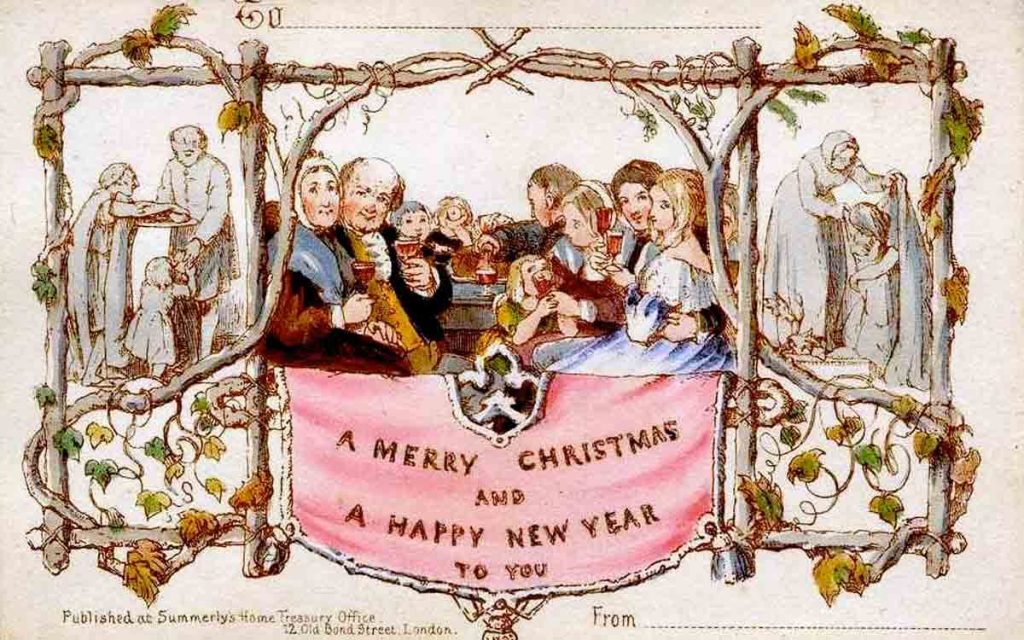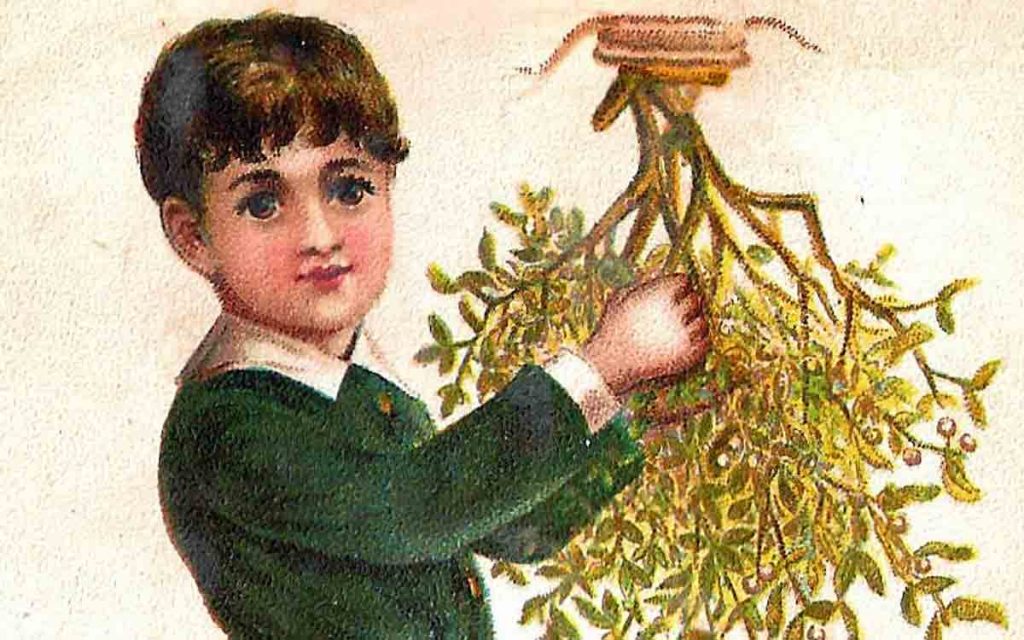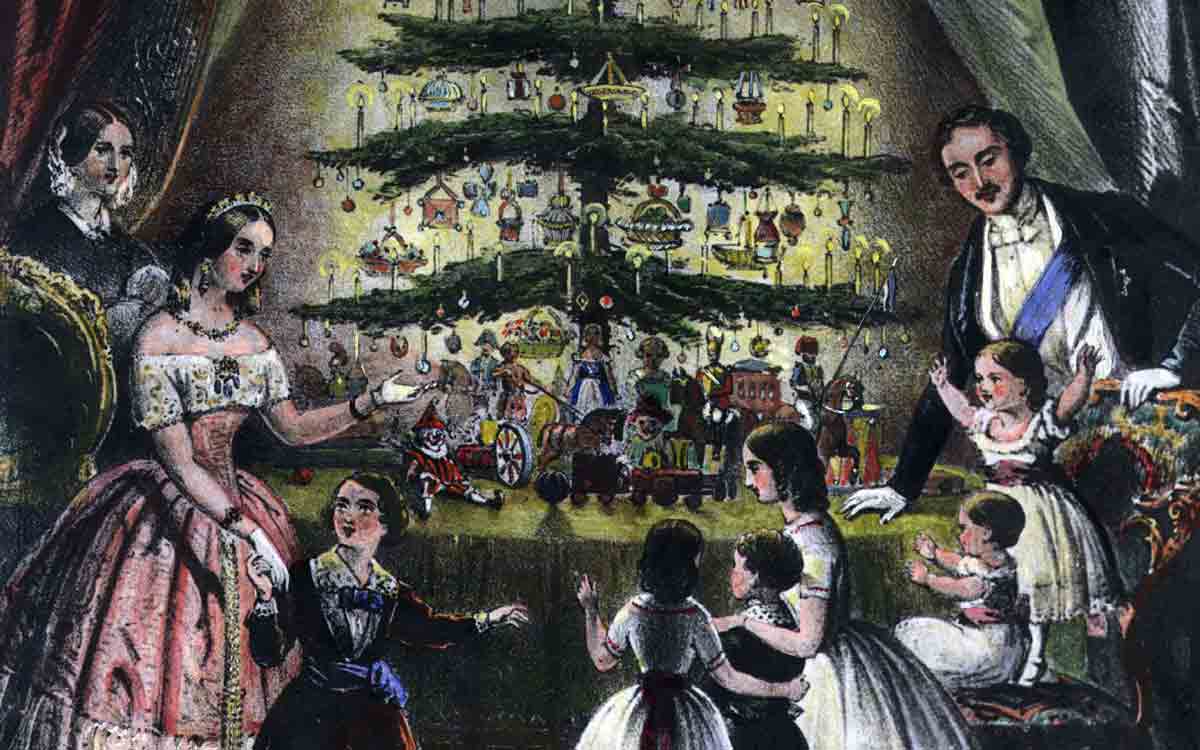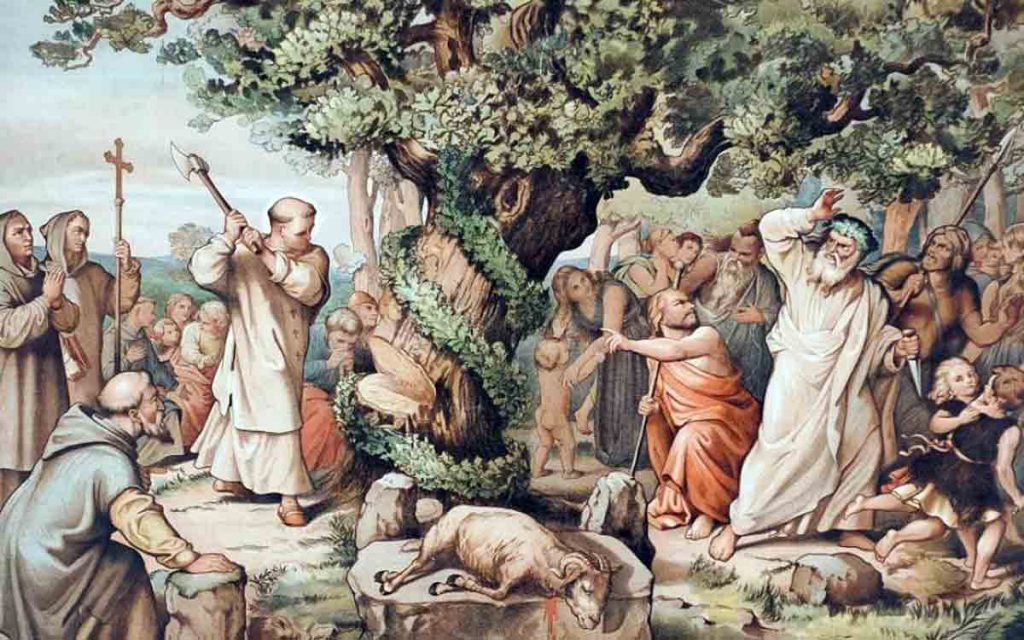CLAIRE BARRAND reveals the spooky backgrounds to many of the ancient Christmas folklore and traditions that we still enjoy!

For most of us, the vision of holly leaves and berries are linked with Christmas, whether we celebrate this as a nonspiritual or a religious event.
Christmas brings with it many traditions, and it is probably the one time when many of us still practice at least a few old folklore customs today without even knowing why we do!
The significance of Holly in Christmas Folklore
Did you know that in some parts of the UK, for example, Holly was once referred to merely as “Christmas,” and in pre-Victorian times ‘Christmas trees’ meant holly bushes?
Holly is brought into the house for its shiny green leaves and berries, which reflect the light and add colour to the dark days of Yule, but it has another significance as well.
Christian symbolism is more well known for being connected to the prickly leaves.
With Jesus’ crown of thorns and the berries with the drops of blood shed for the sake of humanity, for example.
We are familiar with the Christmas carol, ‘The Holly and the Ivy,’ yet even here, the reference to the two plants refers to a pre-Christian celebration.
A boy would be dressed in a suit of holly leaves and a girl similarly in ivy, to parade around the village, bringing Nature through the darkest part of the year to re-emerge for another year’s fertility.
There are dozens of different types of holly.
Virtually all of them come in male and female varieties. Female holly plants cannot have berries unless a nearby male plant pollinates them. It is easy to see why the holly wreath found its way into pagan rituals as a token of friendship and fertility!
Holly was also brought into the house to protect the home from malevolent faeries or to allow faeries to shelter in the home without trouble between them and the human inhabitants.
Whichever of prickly-leaved or smooth-leaved holly was brought into the house first would dictate as to whether the husband or wife was to rule the household for the coming year.
In Celtic mythology, the Holly King was said to rule from the summer to the Winter Solstice, at which time the Oak King defeated the Holly King to order for the time until the summer solstice again. These two aspects of the Nature god were later incorporated into plays traditionally performed around Yuletide. The Holly King was depicted as a mighty giant of a man covered in holly leaves and branches and wielding a holly bush as a club.
However, the folklore of the holly is not solely connected with Yuletide festivities. Like several other native trees, it was felt to have protective properties, and there were taboos against cutting down a whole tree. Hollies were frequently left uncut in hedges when these were trimmed. A more arcane reason for this was to obstruct witches who were known to run along the tops of hedgerows, though more practically farmers used their distinctive evergreen shapes to establish lines of sight during winter ploughing. It is said that the Duke of Argyll even had a prospective road rerouted to avoid cutting down a distinctive old holly in 1861.
Although the felling of whole trees was said to bring bad luck, the taking of boughs for decoration, and the coppicing of trees to provide winter fodder, was permitted. Folklore suggested that the wood had an affinity for control, especially of horses, and most whips for ploughmen and horse-drawn coaches were made from coppiced holly.
Holly trees were also traditionally known for protection from lightning strikes, and so they were often planted near a house. In European mythology, Holly was associated with thunder gods such as Thor and Taranis. We now know that the spines on the distinctively-shaped holly leaves can act as miniature lightning conductors, thereby protecting the tree and other nearby objects. So, you see, science occasionally has an explanation for some things dismissed as superstitious lore!
Ivy also has a history of folklore. Connected to the vine in myth and legend, with both having the ability to change the consciousness – the ivy has, rightly or wrongfully, gained a reputation as being able to undo drunkenness, and can often be seen on public houses signs. Ivy was dedicated to the Greek God Dionysus, the god of intoxication. He is usually seen with a wreath of Ivy on his head and holding a thyrsus or wand which is entwined with ivy and vine leaves.
What is Mistletoe and why is it sacred?

Mistletoe, from the Old English misteltãn, is another Christmas tradition. Most of us buy a sprig from the market to hang up in our homes at this time of year. However, have you ever wondered what is the story behind kissing under the mistletoe? Is it a purely Pagan or Christian custom?
The ancient Druids believed mistletoe to be sacred.
The winter solstice would be the time when the Chief Druid would cut the sacred mistletoe from the Oak. The mistletoe is cut using a golden sickle on the sixth night of the new moon after the winter solstice.
A cloth held below the tree by other members of the order to catch the sprigs of mistletoe as they fell, as it was believed that it would have violated the mistletoe to land on the ground. He would then divide the branches into many sprigs and distribute them to the people, who hung them over doorways as protection against thunder, lightning, and other evils.
The Druids also believed that the berries of the mistletoe represented the sperm of the Gods. Mistletoe was considered a magical aphrodisiac. Girls standing under a sprig of mistletoe were asking for a bit more than a kiss, it seems.
The highly toxic plant in old folklore was, used to cure many ills, and indeed the Druids believed it had miraculous properties which could cure illnesses, serve as an antidote against poisons, ensure fertility and protect against the ill effects of witchcraft.
Mistletoe is also a plant of peace.
If enemies met by chance beneath it in a forest, they laid down their arms and maintained a truce until the next day.
This is thought to be the origin of the ancient custom of hanging a ball of mistletoe from the ceiling and exchanging kisses under it as a sign of friendship and goodwill.
Anglo-Saxons believed that kissing under the mistletoe was connected to the legend of Freya, goddess of love, beauty, and fertility.
According to legend, a man had to kiss any young girl who, without realizing it, found herself accidentally under a sprig of mistletoe hanging from the ceiling.
If a couple in love exchanges a kiss under the mistletoe, it is interpreted as a promise to marry, as well as a prediction of happiness and long life.
It is interesting to note that mistletoe was excluded from church decorations, probably due to its connection with the Druids and its pagan and magical associations. This ancient ban on mistletoe is still widely observed even today.
Poinsettia, a colourful gift to Jesus
Do you buy a Poinsettia to display in your home over Christmas?
An old Mexican legend tells the story of a poor Mexican girl called Pepita who had no present to give the baby Jesus at the Christmas Eve celebrations.
As Pepita walked to the chapel, sadly, her cousin Pedro tried to cheer her up.
“Pepita,” he said, “I’m sure that even the smallest gift, given by someone who loves him will make Jesus Happy.”
Pepita didn’t know what she could give, so she picked a small handful of weeds from the roadside and made them into a small bouquet.
She felt embarrassed because she could only give this little present to Jesus.
As she walked through the chapel to the altar, she remembered what Pedro had said. She began to feel better, knelt and put the bouquet at the bottom of the nativity scene.
Suddenly, the bunch of weeds bursts into bright red flowers and everyone who saw them was sure they had seen a miracle. From that day on, the gorgeous red flowers were known as the ‘Flores de Noche Buena,’ or ‘Flowers of the Holy Night.’
The shape of the poinsettia flower and leaves are sometimes thought as a symbol of the Star of Bethlehem which led the Wise Men to Jesus. The red leaves symbolize the blood of Christ. The white leaves represent his purity. Interestingly this folklore story is also told of the (Helleborus Niger) Christmas rose, which incidentally is not a rose at all but a hellebore, it too has many legends attached to it. Some say it first sprang from the tears of a young shepherd girl who had no gift to give the Christ child in Bethlehem.
Britain’s first Christmas trees

Most of us will put up a tree in our homes, and the first Christmas trees came to Britain sometime in the 1830s. They became very popular in 1841 when Prince Albert (Queen Victoria’s German husband) had a Christmas Tree set up in Windsor Castle.
However, the original legends originate from Germany, and one such story goes like this:
Once on a cold Christmas Eve night, a forester and his family were in their cottage gathered around the fire to keep warm.
Suddenly there was a knock on the door.
When the forester opened the door, he found a poor little boy standing on the doorstep, lost and alone.
The forester welcomed him into his house, and the family fed and washed him and put him to bed in the youngest son’s own bed (he had to share with his brother that night!).
The next morning, Christmas Morning, the family were woken up by a choir of angels, and the poor little boy had turned into Jesus, the Christ Child.
The Christ Child went into the front garden of the cottage and broke a branch off a Fir tree and gave it to the family as a present to say thank you for looking after him.
So ever since then, people have remembered that night by bringing a Christmas Tree into their homes!
St. Boniface and the Christmas Oak

Another story says that St. Boniface of Crediton (a village in Devon) left England and travelled to Germany to preach to the pagan German tribes and convert them to Christianity.
He is said to have come across a group of pagans about to sacrifice a young boy while worshiping an oak tree.
In anger, and to stop the sacrifice, St. Boniface is said to have cut down the oak tree and, to his amazement, a young fir tree sprang up from the roots of the oak tree.
St. Boniface took this as a sign of the Christian faith, and his followers decorated the tree with candles so that St. Boniface could preach to the pagans at night.
Traditionally before the introduction of electric fairy lights candles would be used to light the Christmas tree.
The Legend of the Christmas Spider
We decorate our trees with many things, and one of my favourite Christmas folklore stories is the one of Tinsel and “The Legend of the Christmas Spider”!
These tales seem to have started in Eastern Germany or Ukraine but are also told in parts of Finland and Scandinavia.
All the versions of the story involve a poor family who can’t afford to decorate a Tree for Christmas (in some versions the tree grew from a pine cone in their house, in others the family has bought a tree into the house).
When the children go to sleep on Christmas Eve, a spider covers the tree in cobwebs.
Then on Christmas morning, the cobwebs are magically turned into silver and gold strands which decorate the tree!
Some versions of the story say that it’s the light of the sun which changed the cobwebs into silver and gold, but other versions say it’s St Nicholas / Santa Claus / Father Christmas which made the magic happen.
In parts of Germany, Poland, and Ukraine it’s meant to be good luck to find a spider or a spider’s web on your Christmas Tree.
Spider’s web Christmas Tree decorations are also popular in Ukraine.
They’re called ‘pavuchky’ (which means ‘little spider’), and the decorations are typically made of paper and silver wire.
Here’s an article with some more spiders superstitions and omens!
Dumb Cakes and other Christmas Eve Traditions
There were lots of superstitions in the UK that said girls could find out the initials or even have visions, of the person they would marry on Christmas Eve!
This was often done by cooking a special cake called a ‘dumb cake.’ You were supposed to make the cake in silence and prick your initials into the top. When you went to bed, you left the cake by the fire hearth and your true love was supposed to come in at midnight and prick his initials next to yours.
Other Christmas Eve superstitions included that farm and wild animals would kneel at midnight in honour of Jesus being born or that they could even talk!
Elves have a fascinating history that is associated with Germanic paganism.
Elves are seen initially to be the creation of Germanic paganism who thought them to be the creatures of light who lived in the heavens.
Elves have been depicted as male or female, tiny or dwarf-like, youthful and immortal with magical powers. Later they were often referred to as living underground, in forests, springs, and wells.
Elves generally were magical beings who could control what people see as well as experience. We know that in American Christmas Folklore Santa has elves working alongside him.
But did you know that In Clement Clarke Moore’s 1823 poem “A Visit from St. Nicholas” (more commonly known today as ‘Twas the Night Before Christmas), Santa Claus himself is described in line 45 as, “He was chubby and plump, a right jolly old elf”? Before the influence of St. Nicholas in Sweden, the job of giving out gifts was done by the Yule Goat.
So, you see, there is folklore to be found in all our traditions, and it’s fascinating to discover the origins of some of these.
No longer are those mass-produced plastic mistletoe sprigs or glitter sprayed poinsettia plants going to suffice for me as now I shall find natural and traditional plants so that in keeping with Christmas Folklore beliefs I shall be safe from lightning strikes and malevolent Fae this Yule!
Merry Yuletide xx







